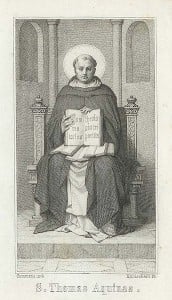 We’re blogging through St. Thomas Aquinas’ Compendium Theologiae, sometimes called his Shorter Summa. Find the previous posts here.
We’re blogging through St. Thomas Aquinas’ Compendium Theologiae, sometimes called his Shorter Summa. Find the previous posts here.
Today’s post is from Chapter 53, “Nature of the Relations Whereby the Father, the Son, and the Holy Spirit Are Distinguished”.
Last week Thomas looked at the relations between the Father, the Son, and the Holy Spirit, and showed that it is these relations that distinguish the Father from the Son. The Son is distinguished from the Father as the thing understood is distinguished from the one understanding; the Spirit is distinguished from the Father and the Son as the thing loved is distinguished from both the lover and the lover’s understanding of it. In creatures like us, these kinds of relations are between things that are truly separate, but Thomas has shown over the last chapters that these things are not separate in God.
But then, one might argue that if these things are not truly separate in God—that is, if God is truly One—then these relations are not real but only mental:
The relations by which the Father, the Son, and the Holy Spirit are distinguished from one another are real relations, and not merely mental relations. Those relations are purely mental which do not correspond to anything found in the nature of things, but depend on intellectual apprehension alone. Thus right and left in a stone are not real relations, but only mental relations; they do not correspond to any real disposition present in the stone, but exist only in the mind of one who apprehends the stone as left, because it is, for instance, to the left of some animal.
If I come across a big stone in the middle of the trail, I might speak of the left side of the stone and the right side of the stone, and pass it on the right. Someone coming the other way would assign the two sides differently, and wouldn’t be wrong to do so: there’s nothing in the stone itself that gives it a left and a right. Thus, this is a purely mental relation, not a real one; it’s simply a useful way for me to think about the stone.
But, Thomas continues,
On the other hand, left and right in an animal are real relations, because they correspond to certain dispositions found in definite parts of the animal.
Suppose if I stop by a stream and catch a fish and notice an unusual spot on the left side of the fish. Later on, I tell others about the unusual spot on the left side of the fish; they will all picture the correct side of the fish, because fish really have a left and a right.
Accordingly, since the relations whereby the Father and the Son and the Holy Spirit are distinguished really exist in God, the relations in question must be real relations, and are not merely mental relations.
When we say that God is Three in One we’re understanding something real; it isn’t simply a useful way to think about God.
This said: the Church in her liturgy doesn’t make the sign of the cross in the name of the Knower and Lover, the Understood, and the Beloved. These are real relations between the Father, the Son, and the Holy Spirit, but that doesn’t mean that they capture the fullness of what it is to be Father, Son, and Holy Spirit. David was the son of Jesse, and is described as such in scripture, but that hardly exhausts who he was. Thus, when we speak of God or to God we use the name He gave us: Father, Son, and Holy Spirit.
____
photo credit: Public Domain; source Wikimedia Commons








